Electronic and Spintronic Properties of Armchair MoSi2N4 Nanoribbons Doped by 3D Transition Metals
Abstract
:1. Introduction
2. Systems and Methods
3. Results and Discussions
3.1. Geometric and Electronic Structures
3.1.1. Pristine Monolayer and Nanoribbon
3.1.2. Nanoribbons Doped by 3d TM Atoms on the Edge
3.1.3. Nanoribbons Doped by 3d TM Atoms Inside
3.2. Electron Transport
4. Conclusions
Author Contributions
Funding
Data Availability Statement
Conflicts of Interest
References
- Novoselov, K.S.; Geim, A.K.; Morozov, S.V.; Jiang, D.; Zhang, Y.; Dubonos, S.V.; Grigorieva, I.V.; Firsov, A.A. Electric Field Effect in Atomically Thin Carbon Films. Science 2004, 306, 666–669. [Google Scholar] [CrossRef]
- Wan, X.; Chen, E.; Yao, J.; Gao, M.; Miao, X.; Wang, S.; Gu, Y.; Xiao, S.; Zhan, R.; Chen, K.; et al. Synthesis and Characterization of Metallic Janus MoSH Monolayer. ACS Nano 2021, 15, 20319–20331. [Google Scholar] [CrossRef]
- Feng, Y.; Shen, L.; Yang, M.; Wang, A.; Zeng, M.; Wu, Q.; Chintalapati, S.; Chang, C.R. Prospects of spintronics based on 2D materials. WIREs Comput. Mol. Sci. 2017, 7, e1313. [Google Scholar] [CrossRef]
- Zhang, S.; Liu, J.; Kirchner, M.M.; Wang, H.; Ren, Y.; Lei, W. Two-dimensional heterostructures and their device applications: Progress, challenges and opportunities—Review. J. Phys. D Appl. Phys. 2021, 54, 433001. [Google Scholar] [CrossRef]
- Wang, S.; Liu, X.; Zhou, P. The Road for 2D Semiconductors in the Silicon Age. Adv. Mater. 2022, 48, 2106886. [Google Scholar] [CrossRef]
- Tan, C.; Cao, X.; Wu, X.-J.; He, Q.; Yang, J.; Zhang, X.; Chen, J.; Zhao, W.; Han, S.; Nam, G.-H.; et al. Recent Advances in Ultrathin Two-Dimensional Nanomaterials. Chem. Rev. 2017, 117, 6225–6331. [Google Scholar] [CrossRef]
- Liu, Y.; Chen, M.; Yang, S. Chemical functionalization of 2D black phosphorus. InfoMat 2021, 3, 231–251. [Google Scholar] [CrossRef]
- Liu, X.; He, J.; Liu, Q.; Tang, D.; Wen, J.; Liu, W.; Yu, W.; Wu, J.; He, Z.; Lu, Y.; et al. Low temperature carrier transport study of monolayer MoS2 field effect transistors prepared by chemical vapor deposition under an atmospheric pressure. J. Appl. Phys. 2015, 118, 124506. [Google Scholar] [CrossRef]
- Gao, G.; O’Mullane, A.P.; Du, A. 2D MXenes: A New Family of Promising Catalysts for the Hydrogen Evolution Reaction. ACS Catal. 2017, 7, 494–500. [Google Scholar] [CrossRef]
- Hong, Y.-L.; Liu, Z.; Wang, L.; Zhou, T.; Ma, W.; Xu, C.; Feng, S.; Chen, L.; Chen, M.-L.; Sun, D.-M.; et al. Chemical vapor deposition of layered two-dimensional MoSi2N4 materials. Science 2020, 369, 670–674. [Google Scholar] [CrossRef]
- Touski, S.B.; Ghobadi, N. Vertical strain-induced modification of the electrical and spin properties of monolayer MoSi2X4 (X = N, P, As and Sb). J. Phys. D Appl. Phys. 2021, 54, 485302. [Google Scholar] [CrossRef]
- Lv, X.; Xu, Y.; Mao, B.; Liu, G.; Zhao, G.; Yang, J. Strain modulation of electronic and optical properties of monolayer MoSi2N4. Phys. E Low-Dimens. Syst. Nanostruct. 2022, 135, 114964. [Google Scholar] [CrossRef]
- Bafekry, A.; Faraji, M.; Fadlallah, M.M.; Khatibani, A.B.; Ziabari, A.A.; Ghergherehchi, M.; Nedaei, S.; Shayesteh, S.F.; Gogova, D. Tunable electronic and magnetic properties of MoSi2N4 monolayer via vacancy defects, atomic adsorption and atomic doping. Appl. Surf. Sci. 2021, 559, 149862. [Google Scholar] [CrossRef]
- Xiao, C.; Sa, R.; Cui, Z.; Gao, S.; Du, W.; Sun, X.; Zhang, X.; Li, Q.; Ma, Z. Enhancing the hydrogen evolution reaction by non-precious transition metal (Non-metal) atom doping in defective MoSi2N4 monolayer. Appl. Surf. Sci. 2021, 563, 150388. [Google Scholar] [CrossRef]
- Tong, T.; Linghu, Y.; Wu, G.; Wang, C.; Wu, C. Nitric oxide electrochemical reduction reaction on transition metal-doped MoSi2N4 monolayers. Phys. Chem. Chem. Phys. 2022, 24, 18943–18951. [Google Scholar] [CrossRef]
- Bafekry, A.; Faraji, M.; Fadlallah, M.M.; Ziabari, A.A.; Khatibani, A.B.; Feghhi, S.A.H.; Ghergherehchi, M.; Gogova, D. Adsorption of habitat and industry-relevant molecules on the MoSi2N4 monolayer. Appl. Surf. Sci. 2021, 564, 150326. [Google Scholar] [CrossRef]
- Cui, Z.; Yang, K.; Ren, K.; Zhang, S.; Wang, L. Adsorption of metal atoms on MoSi2N4 monolayer: A first principles study. Mater. Sci. Semicond. Process. 2022, 152, 107072. [Google Scholar] [CrossRef]
- Linghu, Y.; Tong, T.; Wu, C. Cu-doped MoSi2N4 monolayer as a highly efficient catalyst for CO reduction toward C2+ products. Appl. Surf. Sci. 2023, 609, 155332. [Google Scholar] [CrossRef]
- Abdelati, M.A.; Maarouf, A.A.; Fadlallah, M.M. Substitutional transition metal doping in MoSi2N4 monolayer: Structural, electronic and magnetic properties. Phys. Chem. Chem. Phys. 2022, 24, 3035–3042. [Google Scholar] [CrossRef]
- Li, Y.; Li, J.; Wan, L.; Li, J.; Qu, H.; Ding, C.; Li, M.; Yu, D.; Fan, K.; Yao, H. The First-Principle Study on Tuning Optical Properties of MA2Z4 by Cr Replacement of Mo Atoms in MoSi2N4. Nanomaterials 2022, 12, 2822. [Google Scholar] [CrossRef]
- Guo, S.-D.; Zhu, Y.-T.; Mu, W.-Q.; Ren, W.-C. Intrinsic piezoelectricity in monolayer MSi2N4 (M = Mo, W, Cr, Ti, Zr and Hf). EPL 2020, 132, 57002. [Google Scholar] [CrossRef]
- Guo, S.-D.; Zhu, Y.-T.; Mu, W.-Q.; Wang, L.; Chen, X.-Q. Structure effect on intrinsic piezoelectricity in septuple-atomic-layer MSi2N4 (M=Mo and W). Comput. Mater. Sci. 2021, 118, 110223. [Google Scholar] [CrossRef]
- Zang, Y.; Wu, Q.; Du, W.; Dai, Y.; Huang, B.; Ma, Y. Activating electrocatalytic hydrogen evolution performance of two-dimensional MSi2N4 (M=Mo, W): A theoretical prediction. Phys. Rev. Mater. 2021, 5, 045801. [Google Scholar] [CrossRef]
- Chen, Y.; Tian, S.; Tang, Q. First-Principles Studies on Electrocatalytic Activity of Novel Two-Dimensional MA2Z4 Monolayers toward Oxygen Reduction Reaction. J. Phys. Chem. C 2021, 125, 22581–22590. [Google Scholar] [CrossRef]
- Yu, J.; Zhou, J.; Wan, X.; Li, Q. High intrinsic lattice thermal conductivity in monolayer MoSi2N4. New J. Phys. 2021, 23, 033005. [Google Scholar] [CrossRef]
- Li, S.; Wu, W.; Feng, X.; Guan, S.; Feng, W.; Yao, Y.; Yang, S.A. Valley-dependent properties of monolayer MoSi2N4, WSi2N4, and MoSi2As4. Phys. Rev. B 2020, 102, 235435. [Google Scholar] [CrossRef]
- Yang, C.; Song, Z.; Sun, X.; Lu, J. Valley pseudospin in monolayer MoSi2N4 and MoSi2As4. Phys. Rev. B 2021, 103, 035308. [Google Scholar] [CrossRef]
- Wu, Q.; Cao, L.; Ang, Y.S.; Ang, L.K. Semiconductor-to-metal transition in bilayer MoSi2N4 and WSi2N4 with strain and electric field. Appl. Phys. Lett. 2021, 118, 113102. [Google Scholar] [CrossRef]
- Bafekry, A.; Stampfl, C.; Naseri, M.; Fadlallah, M.M.; Faraji, M.; Ghergherehchi, M.; Gogova, D.; Feghhi, S.A.H. Effect of electric field and vertical strain on the electro-optical properties of the MoSi2N4 bilayer: A first-principles calculation. J. Appl. Phys. 2021, 129, 155103. [Google Scholar] [CrossRef]
- Cai, X.; Zhang, Z.; Zhu, Y.; Lin, L.; Yu, W.; Wang, Q.; Yang, X.; Jia, X.; Jia, Y. A two-dimensional MoSe2/MoSi2N4 van der Waals heterostructure with high carrier mobility and diversified regulation of its electronic properties. J. Mater. Chem. C 2021, 9, 10073–10083. [Google Scholar] [CrossRef]
- Bafekry, A.; Faraji, M.; Ziabari, A.A.; Fadlallah, M.M.; Nguyen, C.V.; Ghergherehchi, M.; Feghhi, S.A.H. A van der Waals heterostructure of MoS2/MoSi2N4: A first-principles study. New J. Chem. 2021, 45, 8291–8296. [Google Scholar] [CrossRef]
- Pham, D.K. Electronic properties of a two-dimensional van der Waals MoGe2N4/MoSi2N4 heterobilayer: Effect of the insertion of a graphene layer and interlayer coupling. RSC Adv. 2021, 11, 28659–28666. [Google Scholar] [CrossRef]
- Hochbaum, A.I.; Chen, R.; Delgado, R.D.; Liang, W.; Garnett, E.C.; Najarian, M.; Majumdar, M.; Yang, P. Enhanced thermoelectric performance of rough silicon nanowires. Nature 2008, 451, 163–167. [Google Scholar] [CrossRef]
- Boukai, A.I.; Bunimovich, Y.; Tahir-Kheli, J.; Yu, J.; Goddard, W.A.; Heath, J.R. Silicon nanowires as efficient thermoelectric materials. Nature 2008, 451, 168–171. [Google Scholar] [CrossRef]
- Ruffieux, P.; Wang, S.; Yang, B.; Sánchez-Sánchez, C.; Liu, J.; Dienel, T.; Talirz, L.; Shinde, P.; Pignedoli, C.A.; Passerone, D.; et al. On-surface synthesis of graphene nanoribbons with zigzag edge topology. Nature 2016, 531, 489. [Google Scholar] [CrossRef]
- Slota, M.; Keerthi, A.; Myers, W.K.; Tretyakov, E.; Baumgarten, M.; Ardavan, A.; Sadeghi, H.; Lambert, C.J.; Narita, A.; Müllen, K.; et al. Magnetic edge states and coherent manipulation of graphene nanoribbons. Nature 2018, 557, 691. [Google Scholar] [CrossRef]
- Bafekry, A.; Faraji, M.; Stampfl, C.; Sarsari, I.A.; Ziabari, A.A.; Hieu, N.N.; Karbasizadeh, S.; Ghergherehchi, M. Band-gap engineering, magnetic behavior and Dirac-semimetal character in the MoSi2N4 nanoribbon with armchair and zigzag edges. J. Phys. D Appl. Phys. 2021, 55, 035301. [Google Scholar] [CrossRef]
- Taylor, J.; Guo, H.; Wang, J. Ab initio modeling of quantum transport properties of molecular electronic devices. Phys. Rev. B. 2001, 63, 245407. [Google Scholar] [CrossRef]
- Brandbyge, M.; Mozos, J.L.; Ordejon, P.; Taylor, J.; Stokbro, K. Density-functional method for nonequilibrium electron transport. Phys. Rev. B 2002, 65, 165401. [Google Scholar] [CrossRef]
- Datta, S. Quantum Transport: Atom to Transistor; Cambridge University Press: Cambridge, UK, 2005. [Google Scholar]
- Kokado, S.; Fujima, N.; Harigaya, K.; Shimizu, H.; Sakuma, A. Theoretical analysis of highly spin-polarized transport in the iron nitride Fe4N. Phys. Rev. B 2006, 73, 172410. [Google Scholar] [CrossRef] [Green Version]
- Khandy, S.A.; Chai, J. Robust stability, half-metallic ferrimagnetism and thermoelectric properties of new quaternary Heusler material: A first principles approach. J. Magn. Magn. Mater. 2020, 502, 166562. [Google Scholar] [CrossRef]
- Chen, C.; Wang, X.-F.; Li, Y.-S.; Cheng, X.-M.; Yao, A.-L. Single-band negative differential resistance in metallic armchair MoS2 nanoribbons. J. Phys. D Appl. Phys. 2017, 50, 465302. [Google Scholar] [CrossRef]
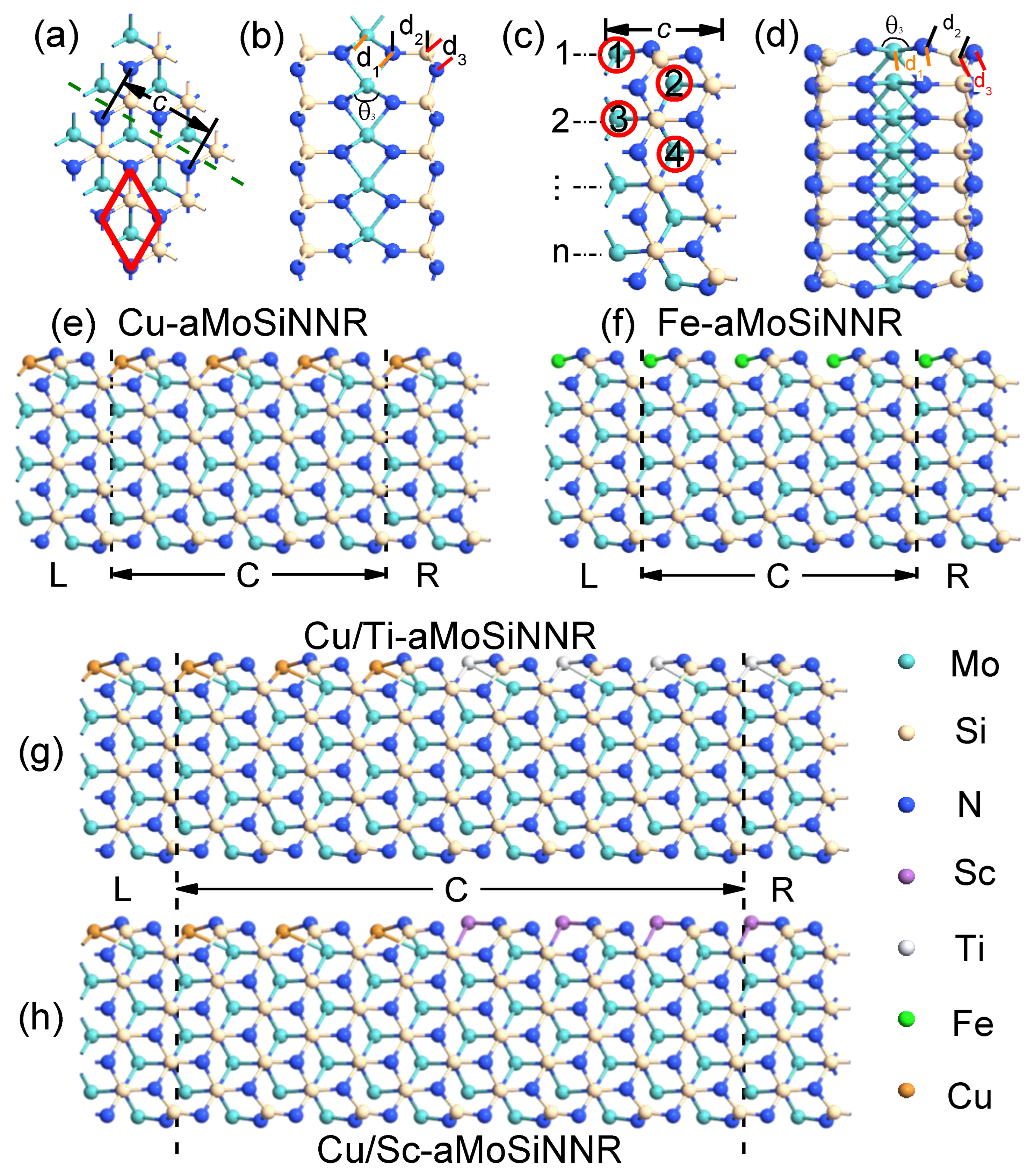
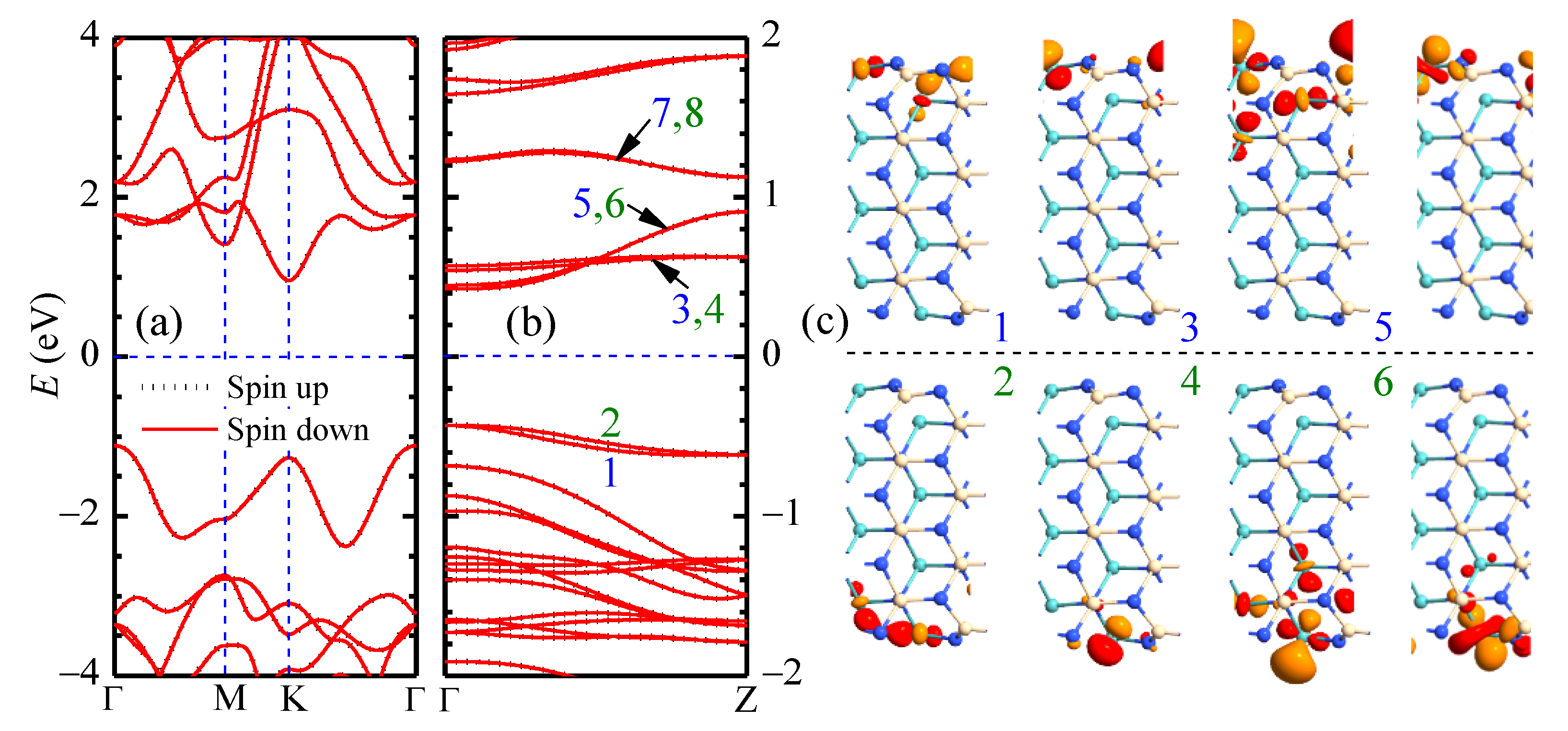

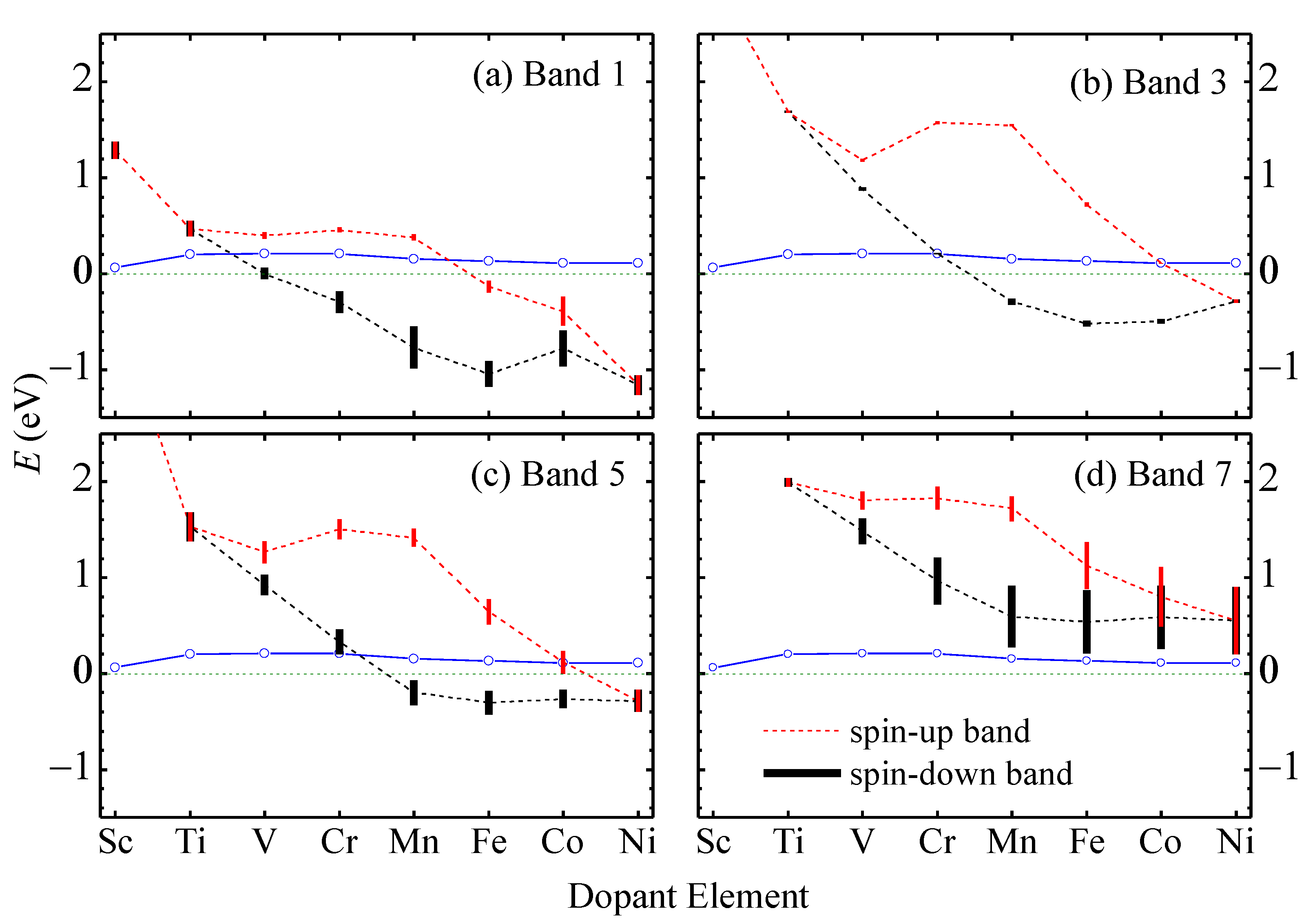
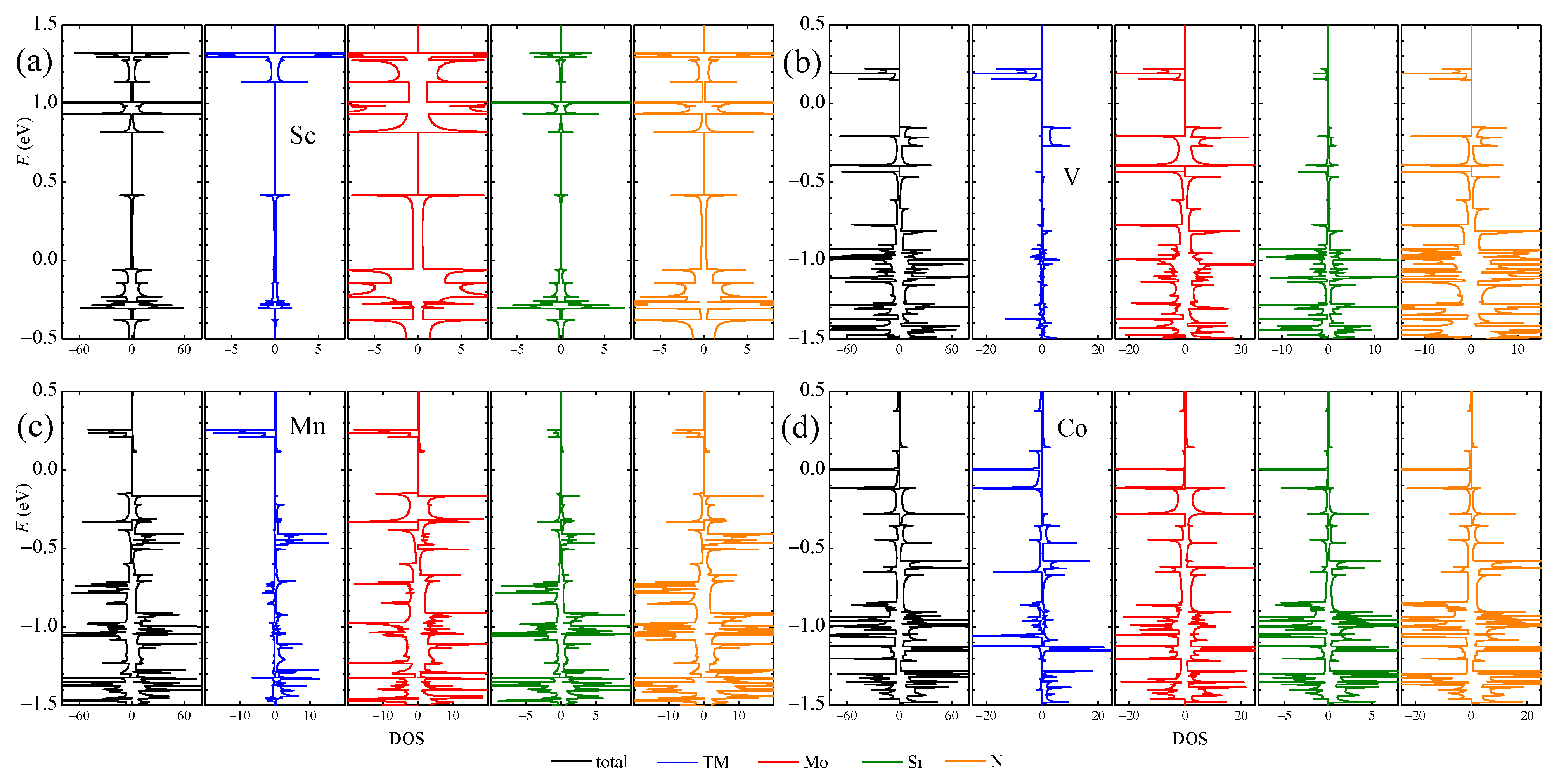
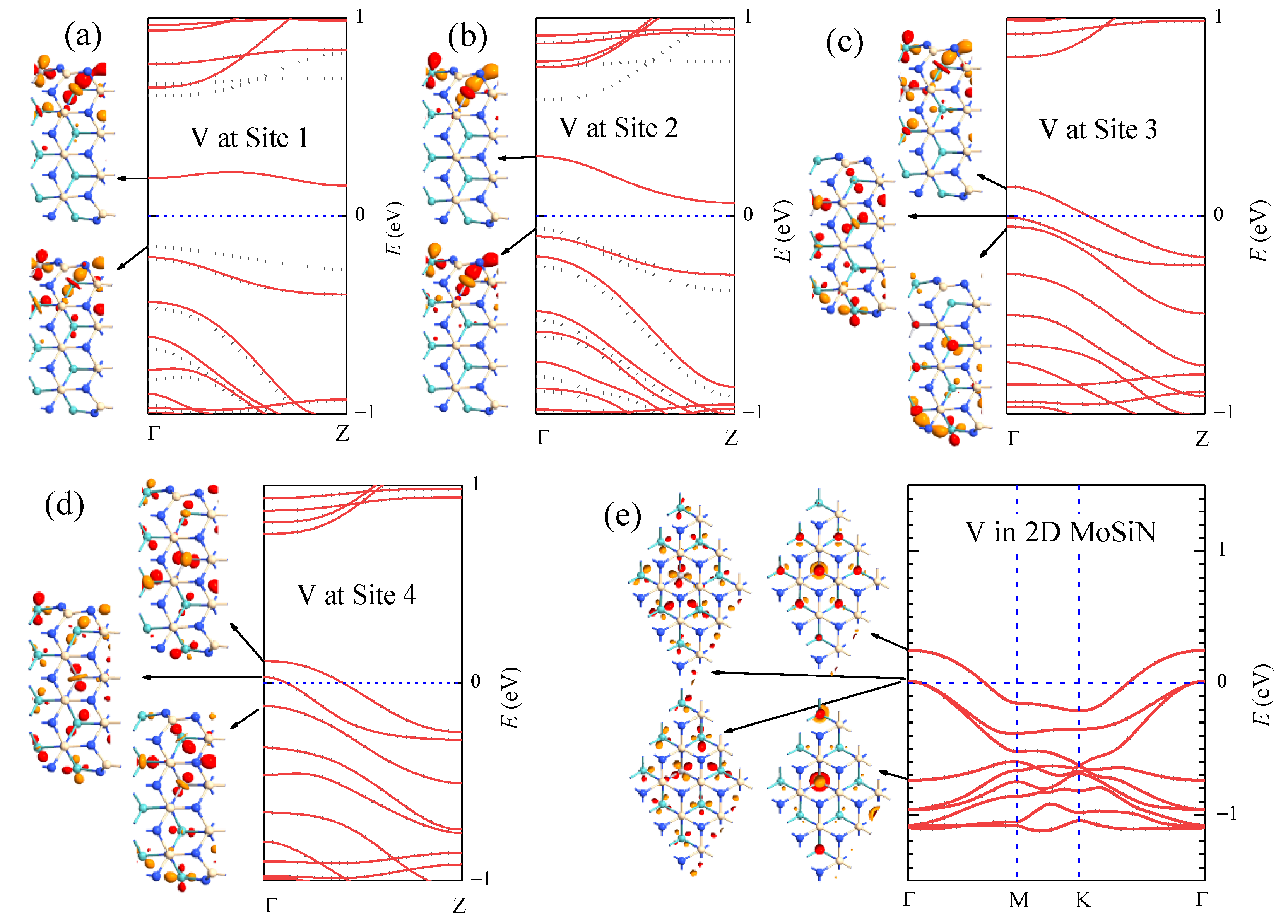


| Config. | c (Å) | d1 (Å) | d2 (Å) | d3 (Å) | θ (°) |
|---|---|---|---|---|---|
| Site 1 | 4.99 | 1.97 | 1.67 | 1.62 | 80.5 |
| Site 2 | 4.99 | 2.09 | 1.78 | 1.73 | 74.5 |
| Site 3 | 4.99 | 2.10 | 1.75 | 1.73 | 73.7 |
| Site 4 | 4.99 | 2.10 | 1.73 | 1.73 | 73.9 |
| MoSiN | 4.99 | 2.10 | 1.73 | 1.74 | 74.8 |
| Dopant | c (Å) | d1 (Å) | d2 (Å) | d3 (Å) | θ (°) | (eV) | (μB) |
|---|---|---|---|---|---|---|---|
| Pristine | 4.99 | 1.97 | 1.67 | 1.62 | 80.5 | 0.00 | |
| Sc | 4.99 | 2.06 | 1.65 | 1.62 | 74.9 | 0.376 | 0.00 |
| Ti | 4.99 | 1.90 | 1.66 | 1.61 | 85.6 | −1.491 | 0.00 |
| V | 4.99 | 1.84 | 1.67 | 1.61 | 87.8 | −1.013 | 1.00 |
| Cr | 4.99 | 1.85 | 1.67 | 1.61 | 85.8 | 1.219 | 2.00 |
| Mn | 4.99 | 1.86 | 1.66 | 1.61 | 84.3 | 2.474 | 3.00 |
| Fe | 4.99 | 1.85 | 1.67 | 1.62 | 82.6 | 1.506 | 2.01 |
| Co | 4.99 | 1.86 | 1.67 | 1.62 | 81.6 | 1.534 | 1.00 |
| Ni | 4.99 | 1.89 | 1.66 | 1.62 | 80.5 | 1.752 | 0.00 |
| Cu | 4.99 | 1.93 | 1.67 | 1.62 | 78.6 | 5.126 | 0.00 |
| Zn | 4.99 | 2.01 | 1.66 | 1.62 | 78.2 | 7.722 | 1.08 |
| Dopant Environment | c (Å) | d1 (Å) | d2 (Å) | d3 (Å) | θ (°) | (eV) | (μB) |
|---|---|---|---|---|---|---|---|
| V-site1 | 4.99 | 1.84 | 1.67 | 1.61 | 87.8 | −1.013 | 1.00 |
| V-site2 | 4.98 | 2.02 | 1.78 | 1.73 | 74.6 | −0.260 | 0.97 |
| V-site3 | 4.97 | 2.03 | 1.75 | 1.73 | 75.1 | −0.302 | 0.00 |
| V-site4 | 4.98 | 2.01 | 1.73 | 1.73 | 75.1 | −0.171 | 0.00 |
| V-MoSiN | 4.99 | 2.02 | 1.73 | 1.74 | 75.1 | −0.165 | 0.00 |
Disclaimer/Publisher’s Note: The statements, opinions and data contained in all publications are solely those of the individual author(s) and contributor(s) and not of MDPI and/or the editor(s). MDPI and/or the editor(s) disclaim responsibility for any injury to people or property resulting from any ideas, methods, instructions or products referred to in the content. |
© 2023 by the authors. Licensee MDPI, Basel, Switzerland. This article is an open access article distributed under the terms and conditions of the Creative Commons Attribution (CC BY) license (https://creativecommons.org/licenses/by/4.0/).
Share and Cite
Su, X.-Q.; Wang, X.-F. Electronic and Spintronic Properties of Armchair MoSi2N4 Nanoribbons Doped by 3D Transition Metals. Nanomaterials 2023, 13, 676. https://doi.org/10.3390/nano13040676
Su X-Q, Wang X-F. Electronic and Spintronic Properties of Armchair MoSi2N4 Nanoribbons Doped by 3D Transition Metals. Nanomaterials. 2023; 13(4):676. https://doi.org/10.3390/nano13040676
Chicago/Turabian StyleSu, Xiao-Qian, and Xue-Feng Wang. 2023. "Electronic and Spintronic Properties of Armchair MoSi2N4 Nanoribbons Doped by 3D Transition Metals" Nanomaterials 13, no. 4: 676. https://doi.org/10.3390/nano13040676






